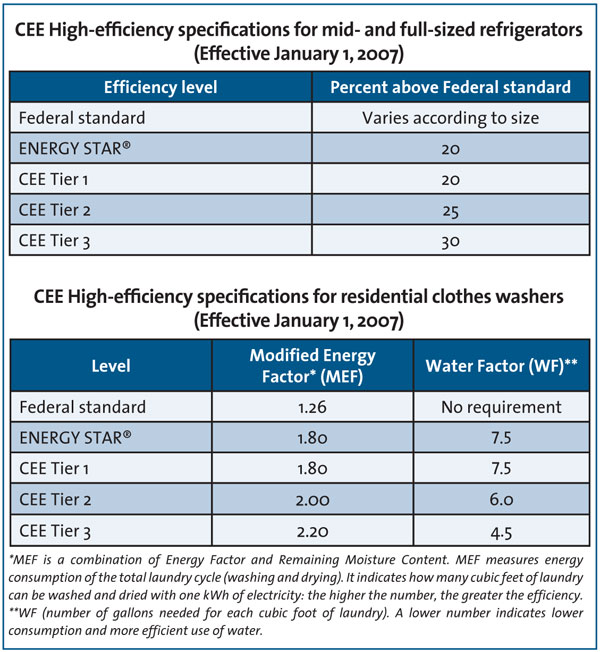This CE Center article is no longer eligible for receiving credits.
If each household in the United States replaced its 1997-and-older appliances with the most energy-efficient models on the market, it has been calculated that the annual overall potential energy savings could be the equivalent of every household driving a car for 242 miles. At present, according to the U.S. Department of Energy (DOE), appliances in the U.S. account for 13 percent of the energy consumed in each household, with refrigerators, clothes washers and dryers at the top of the list. Clearly, since appliances consume significant amounts of energy, design improvements that result in increased energy efficiency can play a meaningful role in the nation's drive for sustainability
After almost a century of virtually no change in the basic design and function of residential appliances, manufacturers have taken on issues of sustainability while delivering improved cooking systems and electronics that were virtually unknown a decade ago. While most appliances have the same basic power access requirements and cutout dimensions as in the past, their performance has improved remarkably. Manufacturers often exceed DOE energy efficiency standards and the future holds even more changes as an ever-increasing number of design professionals and clients seek out sustainable homes. Students at Drexel University, Duke University and the University of Kansas (see sidebar on p.102) have developed their own "smart homes," and the public is exhibiting more and more curiosity, as evidenced by the popularity of the recent prototype on display at Chicago's Museum of Science and Industry. ("Smart" applies to homes that have advanced systems for managing energy usage and efficiency. The term also applies to homes that use integrated computer and sensor technologies to monitor and control both building systems and aspects of daily living such as inventorying refrigerator contents and suggesting menus.) Another impact on appliance design will be the need for two-way digital communication, as smart grids become a reality and household appliances are linked directly to outside power sources.
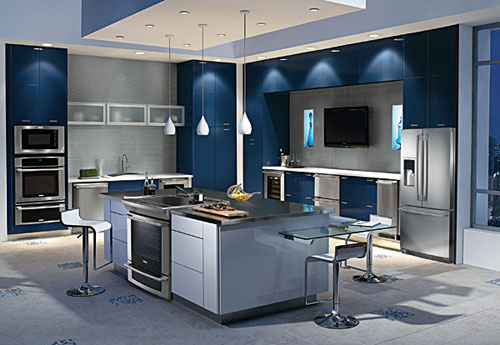 |
|
Photo: Electrolux Home Products, Inc. |
Energy-efficient Appliances for an
Off-the-Grid Prototype |
Studio 804, a design/build program led by Dan Rockhill, AIA, at the University of Kansas School of Architecture and Urban Planning, completed the first LEED® Platinum Home in the Kansas City Metropolitan Area in 2009. The house is a fully self-sufficient "off-the-grid" prototype powered by photovoltaic solar panels and a residential wind turbine.
Its donated ENERGY STAR appliances exceed federal standards by 20 percent for a side-by-side refrigerator (2009 model saves $300 per year compared with a 1980 model) and 83 percent for a front load washer (uses up to 56 percent less water than a conventional top load washer). The dishwasher uses less than five gallons of water per cycle. Cooking appliances include a microwave (no federal energy standard) and a hybrid electric cooktop with two induction elements and a full induction cooktop with all cooking elements being induction.Â
Appliances contributed 3.0 points toward LEED Platinum certification: EA 9.1 High Efficiency Appliances:Â ENERGY STAR labeled refrigerator (1 point); ENERGY STAR labeled dishwasher that uses 6.0 gallons or less per cycle (0.5 point). ENERGY STAR labeled clothes washer (.5 point). EA 9.2 Water Efficient Clothes Washer: Clothes washer with modified energy factor (MEF) greater than 2.0 and water factor less than 5.5 (1 point). (Clothes washer installed has an MEF of 2.31 and a WF of 3.77.)Â
|

|
| Photos: Studio 804 |
Â
Yet "smart" is more than addressing energy efficiency and accessibility standards. Forward thinking design professionals recognize that smart appliance design also serves today's multi-generational consumers and their multiple complex lifestyles. Smart is also about communication where user interface does not only occur between the consumer and appliance, but between the consumer and information - as one manufacturer's popular web-based interactive energy savings calculator confirms.
A recent television commercial shows a TV star dashing from wall oven to washer to dryer to dog to children as she cooks and does laundry at the same time. Even allowing for dramatic license, its message of needing to save time must resonate with adults who are holding down one or two jobs, often at home. Another commercial, albeit imaginary, could send an equally compelling message that smart appliance design is safer for the aging baby boomer whose vision and mobility are compromised. Â
 |
Touch screen control panel for a two-oven electric wall unit
Photo: Electrolux Home Products, Inc. |
Â
Improved appliance ergonomics have benefitted people of all ages. Oven racks that extend fully with the touch of a finger and do not tip even when all are fully extended, dishwasher doors that stay at any angle they are placed, and three tiers of easy-to-reach freezer baskets are examples of manufacturers' response to today's consumer culture.
Smart appliance design also provides greater health benefits. With today's flu epidemics and antibiotic-resistant bacteria, dishwashers and washing machines with certified sanitized rinse cycles are increasingly valued.
It is, therefore, critical that design professionals understand the new technologies and features that contribute to appliance sustainability, rather than specify a product merely because it carries the appropriate energy efficiency sticker.
NEW APPS FOR APPLIANCESÂ
Appliance innovations include increased capacities and more efficient cycle times, as well as sensors that detect dirt and leaks. But the most visible feature found across the broad spectrum of appliances is fully integrated touch screen technology that echoes that of cell phones and gives users the satisfaction of using their mastery over digital technology in the domestic sphere. A step beyond LCD (liquid crystal display) and LED (light-emitting diode) displays, touch screen panels on new models of wall ovens, ranges, dishwashers, washers and dryers, light up at the touch of a finger displaying icons with word descriptors. Like a cell phone the panel is black at rest. After an icon has been pressed and an application for "perfect turkey" or "extra light soil" has launched in the oven or washer, the panel fades to black except for the selected mode, which remains lit.Â
GUIDELINES AND CERTIFICATIONS
ENERGY STAR®
ENERGY STAR is an international voluntary program for energy-efficient consumer products (www.epa.gov). First created by the United States government in 1992 to reduce greenhouse gases, it has since been adopted by other countries, plus the European Union. ENERGY STAR Product Development teams at the EPA and the DOE aim to transform the market for manufactured goods by expanding the availability and visibility of more than 60 energy-efficient product types. One enticement for manufacturers to seek ENERGY STAR ratings is the fact that a number of states and utilities have consumer reimbursement programs for ENERGY STAR-rated products.
Devices carrying the ENERGY STAR logo, such as dishwashers, washers and refrigerators, generally use 20 to 30 percent less energy than is required by minimum federal standards.
Minimum federal standards for appliances are established by the DOE. Performance factors include efficiency levels, incremental equipment prices, operating cost savings, payback periods and lifecycle cost savings. Manufacturers of most home appliances in the U.S. are required to attach a yellow and black sticker to the product stating its annual energy consumption and operating cost estimates.
ENERGY STAR specifications differ with each item. As of early 2008, average refrigerators need 20 percent energy savings over the federal standards. There are no ENERGY STAR specs for cooking appliances since energy-efficient models need far less energy than other heavy energy consumers such as refrigerators and clothes washers. Also, their payback time is relatively long. Nor are there specs for dryers since dryers using the same power sources have virtually indistinguishable drying systems. When applicable, manufacturers' product specifications include ENERGY STAR compliance.
In recent years, the ENERGY STAR program has been involved in some controversies. Criticisms have included outdated testing rules and manufacturers being allowed to test their own products and selectively spot-check test results. To improve the program, the EPA and DOE formed a new partnership on energy efficiency in buildings and products where the EPA has taken over the branding and imaging of ENERGY STAR. In a September 2009 briefing for the Senate Committee on Energy and Natural Resources, the EPA announced an enhanced ENERGY STAR program that includes more frequent updates (a minimum of once every three years for home appliances), enhanced product testing and the intent to look into a new program to identify "top tier" efficiency products and technologies. Already, the Consortium for Energy Efficiency (CEE), a nonprofit public benefits corporation (www.cee1.org), publishes information on appliances that qualify for CEE Tier 1, 2 or 3 (see CEE High-Efficient Home Appliances Initiative tables at right).
Another significant announcement is the requirement that products at some future date are tested in an accredited laboratory and qualifying product information be submitted to the government before the product can be qualified ENERGY STAR. At present, manufacturers have their own testing labs usually located on the factory premises. "Manufacturers will need to keep open and ongoing two-way communication with the EPA /DOE to assure all test procedures are followed," says Tom Anderson, Director of Sustainability, Electrolux Home Products, Inc. "This will allow consumers true peace of mind when they purchase their appliances with the trusted ENERGY STAR label."
Americans with Disabilities Act (ADA)
ADA Accessibility Guidelines (ADAAG) requirements for appliances published by the U.S. Access Board (www.access-board.gov) cover kitchen and laundry room layouts and appliances. Because private homes are exempt from ADA compliance, household appliances are not required to meet standards relating to, for example, location of oven controls ("804.6.5.3 Controls. Ovens shall have controls on front panels"). Design professionals, however, should be aware of accessibility issues and review product specifications to see if models are or are not ADA compliant.Â
Star-K® CertificationÂ
Appliances that comply with a Sabbath Mode feature are certified by Star-K. To be sure that all halachic (Jewish religious law) concerns have been addressed, design professionals should check model numbers from specific manufacturers on the Star-K website.
NSF® Certification
NSF International, an independent non-profit certification body, developed NSF/ANSI (American National Standards Institute) Standard 184 in order to determine if residential dishwashers could clean and sanitize dishes as effectively as their commercial counterparts. This national standard establishes minimum design and performance requirements. Products certified to this standard are verified to achieve a 99.9 percent reduction of bacteria when operated on the sanitizing cycle. Again, manufacturers' product specs will so state if a dishwasher is NSF-certified. NSF also certifies dryers and washing machines.
LEED® Certification
Specifying ENERGY STAR water-efficient appliances will earn three U.S. Green Building Council (USGBC) Leadership in Energy and Environmental Design (LEED®) credits with no prerequisites:
9.1 High-Efficiency Appliances (maximum 2 points). Install appliances from the list below. To receive points for one type (e.g., refrigerator), every appliance of that type must meet the applicable requirement below.
- ENERGY STAR-labeled refrigerator (s) (1 point).
- ENERGY STAR-labeled dishwasher(s) that use 6.0 gallons orless per cycle (0.5 point).
- ENERGY STAR-labeled clothes washer(s) (0.5 point).
9.2 Water-Efficient Clothes Washer (1 point). Install clothes washer with modified energy factor (MEF) > 2.0 and water factor (WF) < 5.5. A clothes washer that meets these requirements and the requirement in EA 9.1 can be counted for both.
Applicants should check for synergy and trade-off options for points.
COOKING APPLIANCES
Gone are the days when women expertly scheduled meal preparation around the single stove whose ill-lit and unevenly heated oven cooked three dishes at once at best. New cooking methods and intelligent controls in today's kitchens allow cooks to focus on the food rather than logistics and treat cooking as a creative and sometimes social act instead of work.
Cooktops
Cooktops installed within islands help make the kitchen the focal point of the home, especially when family members and guests sit across the counter from the cook.
Induction. The most significant technology for surface cookers to come on the market in the past decade is the induction element (see Induction Cooking sidebar.) Typical models come with up to five elements housed within a sealed smooth top glass surface. An LED display with up to ten settings can immediately raise or lower temperatures, maintain food at the perfect serving temperatures and activate an easy-to-read kitchen timer.
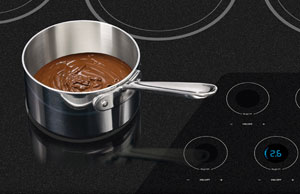 |
|
Photo: Electrolux Home Products, Inc. |
Hybrid induction/electric. For those who want the option of using the conventional electric cooktop, hybrid cooktops with, for example, two induction elements and one or two electric elements are available. Innovations include:
• Expandable induction and electric elements. Some models are equipped with 7-in to 11-in expandable induction elements to accommodate different sized cookware while maintaining energy efficiency. A 6-in burner size provides 1,500 watts; a 7-in provides 1,900 watts; an 8-in provides 2,300 to 3,200 watts; an expandable 7-in to 11-in provides up to 3,400 watts for large pots and pans.
• Cook-surface sensors that automatically detect the presence of induction-ready cookware activate the induction field, and direct heat to the exact diameter of the pot or pan.
Gas. While employing traditional heating mechanisms, gas cooktops have more precisely managed control knobs, dishwasher-safe continuous grates for easily moving pans and at least one dual flame burner that ranges from 450 BTU to 18,000 BTU. Hybrid, gas and electric cooktops are typically ADA compliant.Â
The Science Behind Induction Cooking |
Induction Cooking
Now recognized by Consumer Reports as a mainstream cooking system, induction is completely different from all other cooking technologies. Induction cooking is chiefly distinguished by the fact that the heat is generated directly in the cooking vessel, as opposed to being generated in the range top by electric radiants or burning gas and then transferred to the cooking vessel. An induction element or "burner" is a powerful, high frequency electromagnet, with the electromagnetism generated by sophisticated electronics in the "element" under the unit's ceramic surface. When a good-sized piece of magnetic material - such as, for example, a cast-iron skillet - is placed in the magnetic field that the element is generating, the field transfers ("induces") energy into that metal. The transferred energy causes the metal - the cooking vessel - to become hot. The amount of heat being generated in the cooking vessel is controlled by the strength of the electromagnetic field, which can be changed instantaneously.
Benefits. This form of flameless cooking has certain advantages over conventional gas flame and electric cookers:
- More energy efficient. The DOE reports that the efficiency of energy transfer for an induction cooktop is 84 percent compared with 71.5 percent for electric and 40 percent for gas.
- No wait for preheating. An induction element starts cooking right away.
- Improved thermal efficiency, and greater heat consistency, yet the same or greater degree of precise control as gas. The amount of time that it takes a pot of water to boil depends on the power. That time can be from three minutes for 3600-watt induction elements to around ten minutes for 1200-watt ones.
- Safer in situations in which a hotplate would typically be dangerous or illegal, an induction plate is ideal, as it creates no heat itself. There are no open flames and the "element" itself reaches only the temperature of the cooking vessel; only the pan generates heat.
- Easier to clean because the cooking surface is flat, smooth and stays cool, even though it may have several zones of induction heating. In addition, food tends not to burn onto the cooking surface since it is nowhere near as hot as the pot and contents.
- A built-in induction range is now on the market.
Drawbacks
- Cookware used on it must be made of ferrous materials.Induction cookers do not work at all with non-conducting cookware such as glass or ceramic. Nor will copper or aluminum pans heat up on a typical induction cooker. Cast-iron cookware, including ceramic- or porcelain-coated cast iron, is suitable, as is most stainless steel or clad cookware containing stainless steel.
- Curved-bottom pans, such as woks do not do well except on a correspondingly curved induction unit designed expressly for woks.
- Possibly hazardous for persons with a pacemaker or defibrillator. Users are advised to make their own evaluation and seek the opinion of their cardiologists. There are a number of studies on the subject. For example: "Induction Ovens and Electromagnetic Interference: What is the Risk for Patients with Implantable Cardioverter Defibrillators?" by Christian Binggeli, et al. inJournal of Cardiovascular Electrophysiology, concluded that ICD (implantable cardioverter defibrillator) patients can be reassured that electromagnetic interference (EMI) is unlikely to affect their devices if induction ovens are used in their kitchens. Another study titled, "Do induction cooktops interfere with cardiac pacemakers?" by Werner Irnich and Alan D. Bernstein, which appeared in Europace 2006, concluded that patients are at risk if the implant is unipolar and left-sided, if they stand as close as possible to the induction cooktop, and if the pot is not concentric with the induction coil.
- More expensivethan other electric and gas cooktops.
- Requires careful installation, because the electronics within an induction cooktop need to vent significant amounts of heat during operation. Owing to heat-venting requirements, not all induction cooktops can safely be installed over wall ovens. Design professionals should therefore consult the manufacturer's installation instructions to determine which combinations are considered acceptable.
|
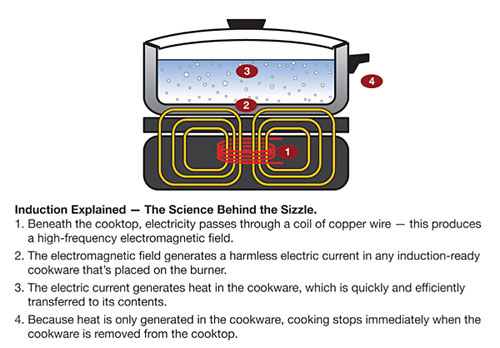 |
| Source: Induction Cooking World |
Wall ovens
The major decision when selecting an oven is choosing between gas and electric. According to New York Times Company-owned ConsumerSearch (www.consumersearch.com), which strives for objective and precise content, experts say electric ovens heat more evenly, have a larger capacity and are generally easier to install. Gas ovens, on the other hand, heat up and cool down faster. However, because ovens tend to be energy efficient in general, the difference is only about $25 per year. The biggest downside for gas is the potential for noxious fumes, especially in today's well-sealed homes. Gas appliances should, therefore, always be vented to the outside.
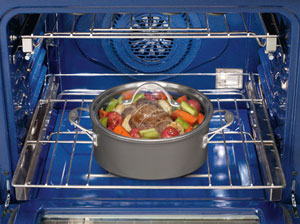 |
Ramp-up high and low-mounted halogen bulbs enable viewing of food cooking in the oven. Easy glide racks will not tip when pulled out together.
Photo: Electrolux Home Products, Inc. |
Electric models typically measure 27-in (3.5 cu ft capacity) or 30-in (4.2 cu ft capacity) wide and are available in a single oven or double oven configuration. New product features can include:
- Fade-to-black touch screen controls with a range of settings that include bake [2,450 watts (27-in)/2,200 watts (30-in]; broil [3,400 watts (27-in)/4,000 watts (30-in]; and convection [2,500 watts (27in and 30-in) for even cooking.] Other settings may include defrost; dehydrate (for drying herbs and fruit); bread rising; and multi-stage cooking.
- A variable-speed convection fan on duel-fuel and electric models provides faster and more even cooking.
- Easy-glide racks mounted on a ball-bearing system that move smoothly and will not tip if pulled out all at once.
- Enhanced visibility inside the oven achieved with an extra-large glass window plus high and low-mounted interior halogen bulbs directed at the top of dishes. Lights gently brighten and dim to achieve a "theater" effect.
- Adjustable baking racks allow multiple dishes to be cooked at once.
- Temperature probe for cooking the perfect turkey activated by pressing a single button.
- Door that stays put at whatever angle it is placed.
Freestanding and built-in ranges
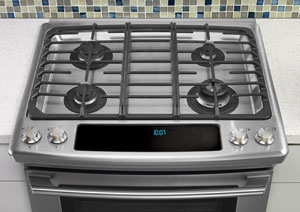 |
Free standing gas range with fade-to-black touch controls in front of the burners. |
Ranges can offer the same features as cooktops and wall ovens (see above), such as expandable electric elements and easy glide racks. Three configurations (dual-fuel, gas and electric) with fade-to-black touch screen controls can offer the largest capacity on the market by adding a lower electric oven. Capacity totals 6.7 cu ft (5.7 cu. ft. upper oven plus 1.0 cu. ft. lower oven.) The two ovens may be set at different temperatures if used simultaneously.
The same innovations found in wall ovens can also be found for ranges.
Warmer drawers. Freestanding and built-in ranges usually include warmer drawers. New warmer drawers can have digital press-controls and an average temperature range between 80 and 210 degrees. They work well with wall ovens, but can be installed separately.
Innovations can include:
- A versatilehalf-width rack.
- Four-hourautomatic power-off.
DISHWASHERS
Dishwasher technology has improved dramatically over the last decade. One improvement is increased capacity. For example, one standard size model can hold 180 items or a 16-place setting with serving plates. Another improvement is energy and water savings. ENERGY STAR qualified models use 40 percent less energy and 33 percent less water than conventional machines. A third example is improved sanitization. NSF-certified models have demonstrated they meet sanitization standards. Other innovations include:
-
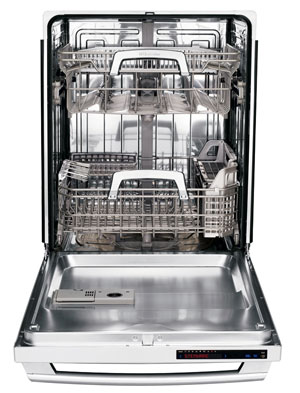 |
Photo: Electrolux Home Products, Inc. |
Smart digital control panels. Some models offer a choice between fade-to-black touch screen and permanently visible digital control panel.
- Enhanced dishwasher power drying using a high-efficiency fan that vents steam and water vapors out of the bottom instead of the usual top - so the dishwasher can be mounted beneath virtually any countertop surface, including granite.
- Improved quietness achieved in a standard size model by a tray-enclosed base that reduces sound and isolates electrical components and wiring.
- Soil sensors that test how dirty dishes are throughout the wash and adjust the cycle to achieve optimum cleaning with minimum water and energy use.
- Expanded water filtration that traps food particles as small as 150 microns so they do not settle on dishes. This permits the efficient use of detergent and water throughout the cycle.
- More efficient jets use less energy to spray detergent and water over the dishes when cleaning.
- Dedicated cycle for washing vertically stacked stemware.
- Adjustable and removable rack design that maximizes cleaning by strategically situating the dishes.
- Racks that glide easily.
- Leak detection system warns of leaks before they can cause damage. After detecting a leak it immediately stops and drains the appliance while sounding an audible and visible alarm.
- Door stays put at whatever angle it is placed.
REFRIGERATORS
A 20-year-old avocado refrigerator with chrome handles may have vintage appeal, but sentimental attachment costs money. According to the EPA, a refrigerator made before 1993 costs an additional $100 each year to operate.
French door refrigerator
 |
Example of French door refrigerator with ramp-up interior lighting.
Photo: Electrolux Home Products, Inc. |
The French door or "double door" refrigerator is a fairly recent popular design. It has equal sized double doors at the top and a pull out freezer below. Its width provides the space advantage of the single door refrigerator that has a freezer below, at the same time as having two doors which can be opened one a time to save energy. French door refrigerators can come in two configurations - one with an icemaker and filtered water dispenser and one without for a more streamlined look. Having narrow refrigerator doors and a pullout freezer drawer avoids the need for a wide door radius. French door refrigerators are not ADA compliant.
Freezers with more than one drawer allow for better organization. One model has three easy-glide freezer baskets with removable/adjustable dividers for organizing food.
 French door design is at least 20 percent more energy efficient than the minimum federal government standard. Another major benefit is larger capacity. For example, one counter-depth (28-3/16-in) refrigerator provides 23 cu. ft. of space, which is more than many standard-depth units offer. A larger typical Tier 3 ENERGY STAR-rated 36-in wide model with a standard depth of 33-in offers 28 cu. ft. of space and is 30 percent more efficient than is required by federal standards.
Side-by-side refrigerators
These have long been a popular choice. New models have increased capacity with a typical counter depth unit offering 23 cu. ft., with the same amount of shelf space as a typical 26 cu. ft. standard-depth model. This design is ADA compliant.
 |
Cut-out dimensions for 23 cu ft counter-depth French door refrigerator
Drawing: Electrolux Home Products, Inc. |
Â
Innovations for new model refrigerators can include:
-
 |
A perfect-temperature refrigerator drawer with multiple touch screen settings store foods at their correct temperatures.
Photo: Electrolux Home Products, Inc. |
Touch screen control panels.Fade-to-black touch screen and LED temperature displays are choices on typical models. Touch screen controls, which remain visible, are options on lower price point units.
- Perfect temperature drawer. Controlled by fade-to-black touch screen technology, an adjustable temperature drawer keeps foods and beverages at their ideal temperature, such as, a fish/shellfish setting at 28 degrees F, a perfect marinade at 37 degrees F and white wine at 42 degrees F.
- Ramp-up lighting with a number of LED lights embedded in the wall and drawers that focus on the stored food.
- Air filter circulates clean air throughout the interior prevents the transfer of odors.
- Dual carbon block hermetically sealed water filter.
- Self closing doors
- Alarm system activated if there has been a power failure, if a door stays open longer than a certain number of minutes or if the interior temperature remains above 55 degrees.
LAUNDRY APPLIANCES
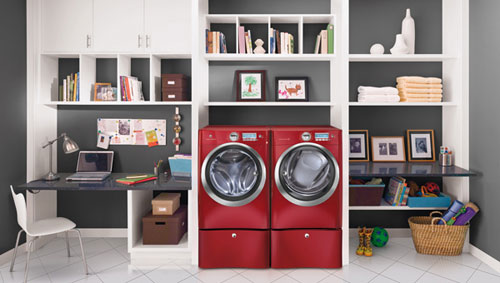 |
Large capacity and fast washer and dryer have a drawer for storing detergents.
Photo: Electrolux Home Products, Inc. |
Â
Calling laundry "the American housekeeper's hardest problem," Catherine Beecher, advocate of bringing rationalization and dignity to housework, saw the advent of the world's first patented washing machine in 1846 but did not live to see the first electric clothes washer introduced about 1900. Her graphic descriptions of the staggering amounts of time and labor it took to wash just one load that used 50 gallons of water and caustic soaps are scarcely believable in light of today's washers and dryers.
What took hours of work can now be accomplished in a mere 18 minutes to wash and 18 minutes to dry in the fastest and largest ENERGY STAR rated machines presently on the market. With 4.7 cu. ft. capacity that can wash 23 lbs of laundry, these particular washers are 83 percent more energy efficient and use 56 percent less water than federal standards. Gas and electric dryers have an 8.0 cu. ft. capacity and the industry's largest moisture sensor that ensures even drying and prevents damage and overheating of clothing. In addition, three 1,800 watt heater elements provide temperature control over a range of settings.
Other innovative features can include:
- Steam dryer that removes wrinkles and freshens clothes.
- Balance system, which keeps over-sized loads, balanced for smooth and quiet vibration-free operation.
- Tumble system that employs a third vane to separate, lift and redistribute clothes while drying.
- Fade-to-black touch screen control panel offers several wash and dry cycle options plus settings such as ‘delay start' and ‘add steam option.'
- Sanitized rinse cycle, certified by NSF®.
- Pedestal drawers below washer and dryer for storing detergents.
- A large door opening for easy access.
- Drying technology that tumbles clothes in two directions for decreased tangling, more even drying and fewer wrinkles.
- Reversible doors that are easily changeable for users' convenience
DESIGN AND AESTHETICS
Since Europe is often considered about two years ahead of the curve in appliance design, U.S. manufacturers do well to keep an eye on the latest trends. Built-in kitchens and office-style curvilinear kitchen layouts were first seen in Europe, as were made-to-measure ranges in shapes that echo partners' desks and perfect ovals. But the U.S. as the home of mass production approaches appliance design with pragmatism. Manufacturers mostly reference European forms - but are taking a serious look at the colors, finishes and materials seen in Europe. The saturated hot red, Mediterranean blue and turquoise sky color options on some new washers and dryers echo recent European models - as does stainless steel, which was once the province of premium-priced European brands. New U.S. models have improved stainless steel coatings, which minimize complaints about fingerprints.
There was speculation about the next wave of finishes at the 2009 Eurocucina show in Milan where some appliances had mirror-like finishes. Since it takes approximately one year to add a new finish - but far longer to change technologies - it is conceivable that design professionals may soon be presented with additional choices to the predominant offerings of black, white and stainless.Â
Some new design features are driven by consumer demand, such as the pedestal drawer in the base of some washers and dryers. Others are the result of new digital technology, for example, the smooth uncluttered look generated by touch screen panels. But the most noticeable change in recent years is attention to designing appliances as a family whose members unmistakably belong to each other.
CONCLUSION
Driven by the need for sustainability and supporting today's consumers, appliances are different from those of just ten years ago. They can exceed federal energy standards by as much as 80 percent, at the same time as offering support and accessibility for people of all ages and lifestyles. While design professionals evaluate innovations and note color finishes, they should also be aware that appliances are a player in the drive for sustainability.
Â
 |
Recognized throughout Europe as the gold standard of appliances, Electrolux appliances have been used in fine European homes and restaurants for more than 80 years. With 120 designers at six design centers on five continents, Electrolux appliances feature a truly unique design and quality that have set the standard in the appliance industry. To learn more about Electrolux Major Appliances, please visitelectroluxappliances.com. |
|




